|
|
Post by Lee Martin on Oct 22, 2013 9:23:50 GMT -5
Based on our conversation from last night there's a lot of useful information to be conveyed here. With that I'll turn it over to David. _____________________________________________________________________________ Early Colt Delta Elite 10mm, field stripped. Federal Hydra-Shok 180 JHP. 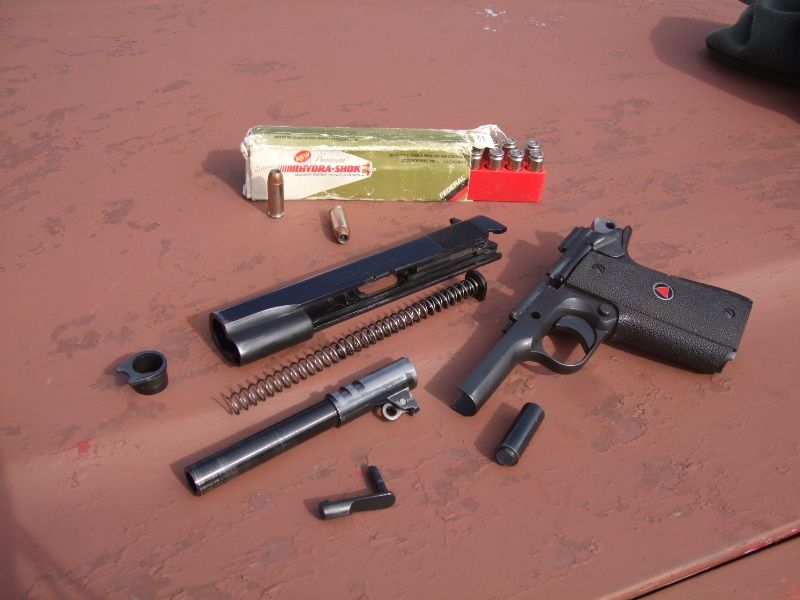 Colt Delta Elite 10mm, circa 1980, veritable lesson in combining accuracy with reliability. Leather proven over the years----# 85----by Gene DeSantis  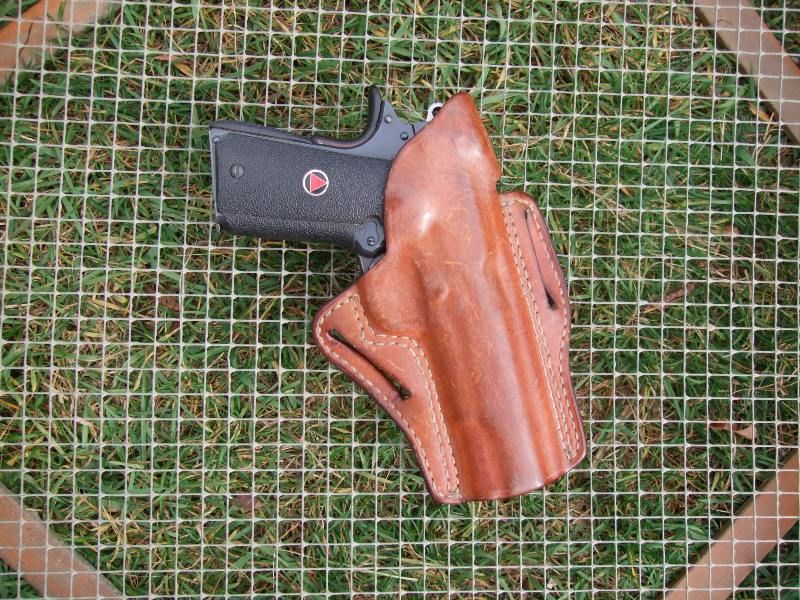 10mm Auto ammo found after nine years entombed in humidity. About 400+ rounds, all but a dozen factory. Rather than throw it all out, time for a little experiment. Let us see how much of it chambers and shoots. Hornady XTP, brass case Speer Blazer, aluminum case 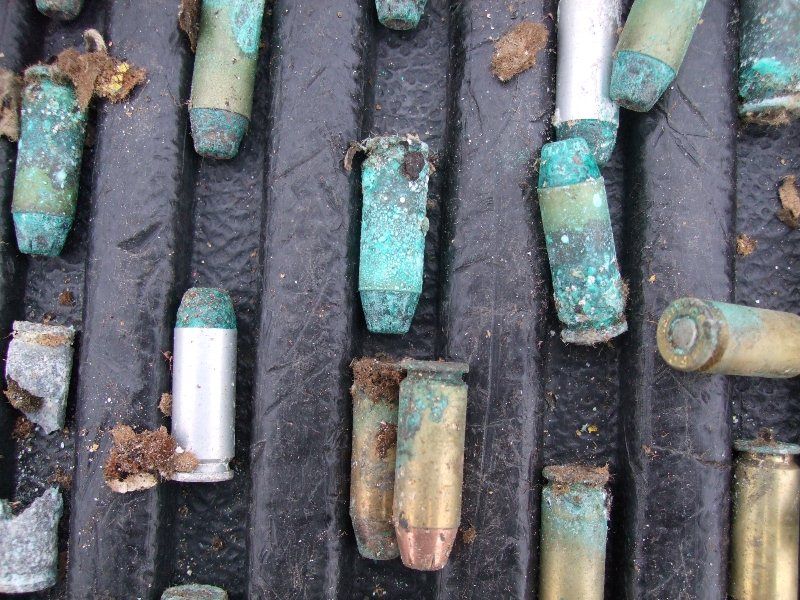 Hornady XTP, a couple of misfires; overall pretty damn reliable  These two Hornady 10mm XTP fed from magazine and discharged, with seeming full authority. 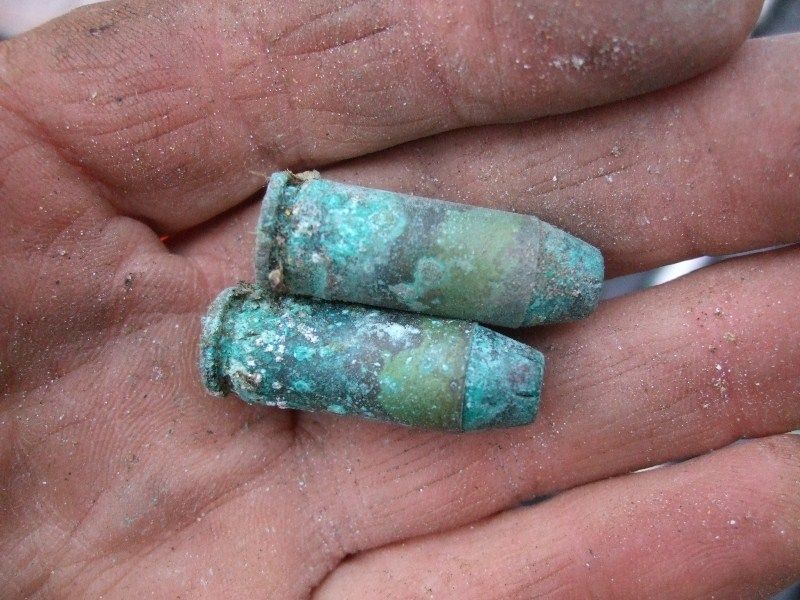 No misfires so far with Federal Hydra-Shok in nickel case. Perfect feeding and blasting thrown wood blocks. 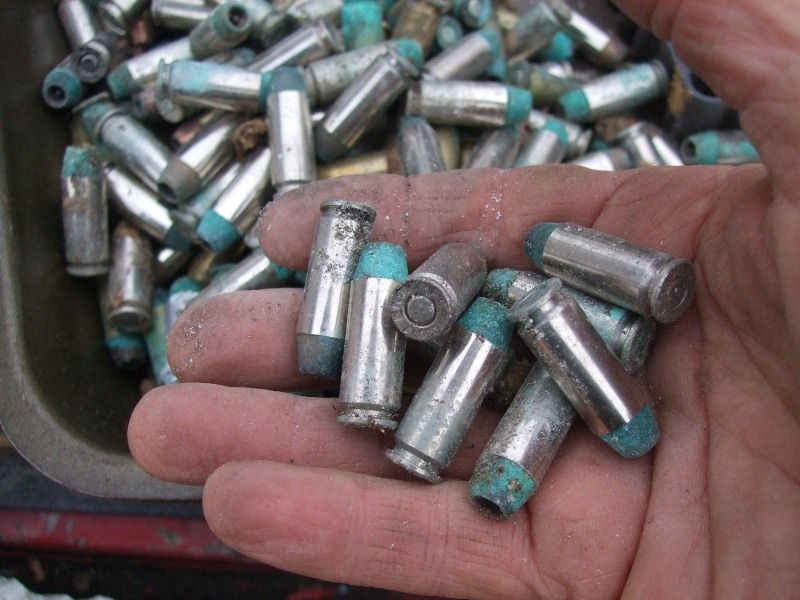 Speer Blazer aluminum case----by far the most failures to feed, do to aggressive corrosion. Estimate 30 to 40% misfires of chamber-able Blazer  Speer alluminum case Blazer----two blown case heads, so far. Face sprayed with debris (glasses).  Aluminum by far the weakest case, and most susceptible to corrosion.  -Lee www.singleactions.com"Building carpal tunnel one round at a time" |
|
|
|
Post by alukban on Oct 22, 2013 9:32:40 GMT -5
"thrown wood blocks" AHEM!  I guess I know what I'm doing this weekend! |
|
|
|
Post by bradshaw on Oct 22, 2013 11:03:07 GMT -5
Boxed factory ammunition trapped in garbage bag from 2004 to 2013, just about ten year. Humidity got in, couldn't escape. Most cardboard containers crumbled to damp dust. Plastic cartridge trays good as new. Cardboard cartridge trays mostly turned to oatmeal. Many aluminum Blazer cases corroded right through. Powder granules span spectrum of deterioration. Federal nickel cases survived ordeal amazingly well.
Thus far, two blown aluminum caseheads, spraying face with particles. Shooting glasses of course a must. Feels as though particles blew rearward between frame & slide, although i can't be sure. No damage to Colt Delta Elite, nor much spray against cartridges in magazine. Impossible to judge beforehand which aluminum cased round will misfire. Blown casehead ammo felt somewhat anemic compared to a healthy round, suggesting powder contamination. Corrosion grows on aluminum. I make no statistical pretense in this SEE-WHAT-SHOOTS experiment. Nevertheless, that this assortment of 10mm ammo suffered exactly the same lousy storage confers validity. Reckon electrolysis played a part, as the aluminum case---the rottenest apple in the basket----attacked first itself, second the copper bullet jackets, then the brass, with slightest affect on the nickel.
Persons storing ammo on boats or an otherwise humid environ might see in my folly a cautionary tale.
My above-stated "30 to 40%" misfire rate with Speer Blazer is a guesstimate made in error, compounded by faux statistical reference. My SWAG tells me about 1/4 to 1/3 of Blazer misfired. Blazer ammo corroded in half or beyond recognition isn't counted, but sure as shootin' would raise the failure rate. Note again, truth is not statistical----we cannot know whether ammunition too corroded to chamber will fire, hangfire, or misfire. Disinclined at moment to scrub aluminum cases to see how many more will chamber.
Plenty of Hornady and Federal 10mm to try. To pursue curiosity, I may take steel wool or Scotchbrite pad to the brass case Federal and Hornady. So far, no brass or nickel cased round has failed to feed from the magazine, although there have been two Hornady misfires.
This Colt Delta Elite has been a magnificent performer from the day I started shooting it, about 1980. This takes the gun completely out of the equation as a culprit in ammunition failure. Got a lot of practice clearing jams, as the heavy 10mm spring tries its best to chamber corroded ammo. I prefer Browning's guidance of recoil spring by slide & frame----retained in the Delta Elite----to the long recoil spring guide rod. To eject an aluminum case jammed half-way in the chamber, I place the spring plug (front of slide) against a firm surface----bench, log, tailgate----and push down.
A misfire is handled as an incipient HANGFIRE. Wait at least a few seconds. The one hangfire, so far, exhibited about 1/4-second between primer strike and discharge.
David Bradshaw
|
|
|
|
Post by bradshaw on Oct 22, 2013 12:17:50 GMT -5
The Delta Elite is original and stock, except for the comfortable Pachmayr straight grip safety and half-arc mainspring housing, with modest work on the trigger. Said Pachmayr grip safety is rubber (neoprene?) on contact areas. Could call the Pachmayr 1/2-round mainspring housing a beavertail housing, as the rubber surface is frame-width and checkered.
David Bradshaw
|
|
|
|
Post by Lee Martin on Oct 22, 2013 13:15:43 GMT -5
Wonderful write-up as always David. Like you, I've had a thing for the 10 Auto since I first shot a Delta in 1988. Here are the two we discussed last night: 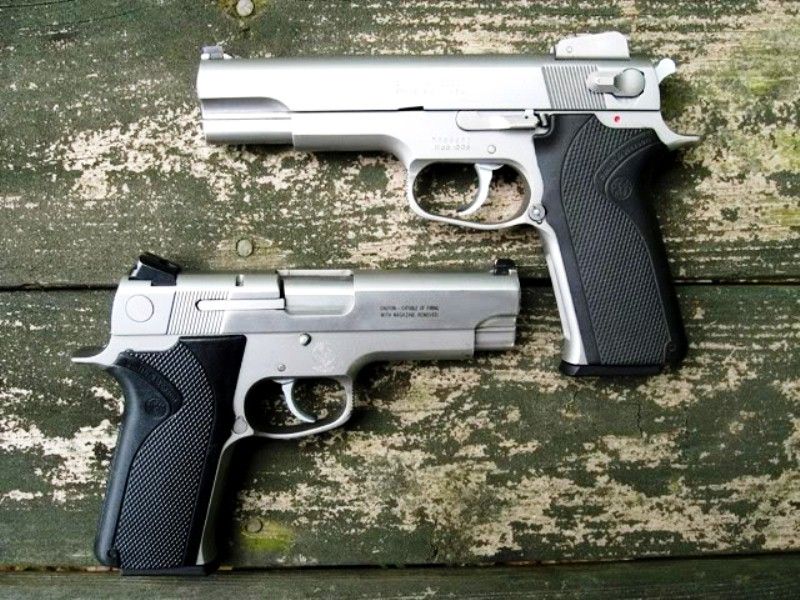 I plan to try some AA #7 soon. Hopefully it'll move me to buy a 1911 based 10 (something I've been meaning to do for over 20 years). -Lee www.singleactions.com"Building carpal tunnel one round at a time" |
|
|
|
Post by jayhawker on Oct 22, 2013 15:43:44 GMT -5
Great info. I shot one of the first Colt 10's in Tombstone AZ when Joe Walsh, who was doing promotinal work for Colt, was there at a Fast Draw contest and put on a live ammo exhibition. He had one of the first 10's. I was able to split a playing card with it on the 3rd or 4th shot.
Joe was a police Officer that shot DA revolvers extremely well. He broke McGivern's 10shots with 2 guns at once speed record with S&W revolvers. Contacted S&W and they were not interested. So he contacted Colt and they supplied him with a pair of Pythons. He again officially broke McGivern's record with the Colts. But only after the Custom Shop modified the Python actions, as Joe could tie them up by triggering them faster than they could function. Sorry if I hi-jacked the thread. The 10 MM is a supperior cartridge in an auto pistol. Unfortunately the Bren 10 fiasco pretty well killed it.
|
|
mark
.30 Stingray

Posts: 207
|
Post by mark on Oct 22, 2013 20:06:21 GMT -5
David,
Thanks for sharing your story. This is a good example that helps with value of a nickle case. I wonder if the corrosion increases the chamber presure. I would bet it does.
I was (still am) a big fan of the 10mm. I wish it would have captured more commercial success. My 10mm experience revolves around a G20. I really enjoyed that gun. When a friend offered to trade his 4 inch S&W 29 born the same year I was for my G20, I took him up on it. I would do that trade over and over again if I had to. That 29 is a keeper and there was no G20 born in 1972. As much as I loved the 10mm, I never went back.
Mark
|
|
|
|
Post by contender on Oct 22, 2013 21:11:45 GMT -5
An excellent example of a type of test many of us hope to never have to try! But, knowing such stuff will help us decide "if we have to!"
|
|
|
|
Post by bradshaw on Oct 23, 2013 9:19:30 GMT -5
jayhawker.... little question that a knowledgeably tuned Python double action cycles very fast. Handled a couple of Pythons done for Chick Gaylord, with gold-plated hammers & triggers; very slick revolvers. It's up to the shooter to sort out whether the S&W or Colt is faster, coming down to the individual on the trigger. The Python may be tuned light, with reliable DA. The Smith cylinder spins easier. Let the boys who are good at it sugar it off. In an attempt to encourage the chief investigators to shoot steel at the Attorney General's IHMSA match in Vermont years ago, I drew my 4-inch M-29 and cleaned the rail of chickens at 50 meters----double action with Federal 44B .44 mag 180 JHP. Not true speed shooting, just trying to squeeze trigger straight through smooth as possible. Nor does anyone stage a Python trigger in speed shooting.
Mark.... my impression is that when corrosion reaches inside the case, moisture/corrosion chemistry begins to attack the powder. Have yet to sugar off my own thoughts on progressive effect of corrosion. Misfires with the CCI Blazer involve deactivated primers. No primers have fired without igniting powder and expelling bullet from barrel. A live primer against dud powder pushes bullet into rifling. As a hedge against reloading, CCI/Speer Blazer ammo is Berdan primed. No direct way to check whether Boxer primers would survive corrosion exposure any better than the Berdan. With Berdan, the anvil is built into the case, and the priming pellet seats against the anvil. With the Boxer primer, some sort of barrier coats the explosive pellet, and a separate anvil is pressed into the primer cup over the pellet. As a rule, primers should be kept dry.
Had the aluminum case heads blown out under 35,000-40,000 psi, I believe the magazine would have departed the mag well, and the grips bulged. The Colt has excellent chamber support; otherwise, case failure should have been worse. With chronograph gear put away, I shall rely on 100 yard targets to indicate load consistency. Amazes me how clean the Colt 10mm is after firing such filthy ammunition. (Photos taken of CLEAN pistol).
The Glock 20 probably has done more to keep the 10mm alive than any other pistol. Leastwise, I see more Glock 10mm's out there. The 10mm in a 1911 has a substantial ring of steel around the chamber. The square chamber section of the Glock design requires a thick slide to provide some meat around the chamber. Note the thin sidewalls of a Glock in .40 S&W, which, when they let go, typically split at 9-and-3 o'clock. Beyond that, the plastic frame provides an intrinsic buffer. The Delta Elite incorporates a plastic spring guide as buffer. Unless the guide/buffer is replaced with the factory part, an insert buffer should be used.
contender.... thanks. Perhaps someone on the electrical side will throw in with his or her take on aluminum-electrolysis. Many years ago, aluminum poles were marketed to replace wood tamping poles in dynamite work. Some blasters tried the aluminum poles, pumping them in boreholes. A few blasters were sent to join the Feathered Choir, as electrolytic action between pole and rock set off EBC's (Electric Blasting Caps).
David Bradshaw
|
|
|
|
Post by bradshaw on Oct 24, 2013 8:57:27 GMT -5
As of yesterday...
Federal 10mm has pulled way ahead of Hornady, with Hornady way ahead of CCI Blazer. Lee or Max will post photos.
Cleaned----0000 steel wool----most of the Federal nickel case ammo, loaded with the excellent Hydra-Shok 180 JHP. As photos will show, while the copper jacketed bullets are green with oxidation, the nickel cases look new. Corrosion on the nickel cases is not in the nickel itself; corrosion comes from proximity to aluminum cases, brass cases, and jacketed bullets. Federal loaded the Sierra 180 JHP in brass case and called it Hi-Shok. The Federal brass shows noticeably LESS corrosion than the Hornady brass. No misfires or squibs, yet, with Federal. Yesterday I had one Hornady 10mm 180 XTP misfire, and two made the POP sound of a loud blank, with the shell probably pushing the slide rearward----short of contact with ejector----and the slide rechambering the fired shell.
One failure to feed with Federal brass case Hi-Shok. This is NOT a feed ramp stoppage. Cartridge stops half way into chamber----rough, dry corrosion on brass, compounded by accumulated corrosion of previous Hornady and Federal brass, all of it shedding dry green corrosion. Note that this ONLY stoppage with Federal was the FIRST round from the Colt 10mm magazine loaded with 8-rounds of corroded ammo. Friction of the corroded rounds squeezed tightly in magazine is very high. Said magazine has accumulated beau coups granular corrosion particles. Just the friction of loading the dirty mag with corroded ammo is tiresome.
* Hornady XTP 180 JHP, brass case----three misfires to date; two loud, blank-like POPs. Accuracy not on par with Federal.
* Federal Hi-Shok Sierra 180 JHP, brass case----one 1/2-chamber stoppage due to corrosion. Excellent consistency, with no failure to fire. Tried a shot at a stone the size of a grapefruit at 200 yards; close miss----4 o'clock about six inches.
* Federal Hydra-Shok 180 JHP, nickel case----perfect feeding and consistency, so far. Second-round hit on stainless dairy pot at 200 yards. No failures of any kind.
I attribute reliability of the Federal ammo after years of terrible humidity to the seal of primer in primer pocket and bullet in case neck.
David Bradshaw
|
|
|
|
Post by Lee Martin on Oct 28, 2013 15:06:42 GMT -5
More photos from David..... Federal 10mm Auto Hydra-Shok 180 JHP; nickel case cleaned with ---- steel wool. No corrosion of case after nearly 10 years humid entrapment. Consistent thus far, no failures to fire.  10mm Auto 180 XTP. One misfire today; two produced a sharp BANG, similar to a blank, and left shells in chamber----insufficient recoil 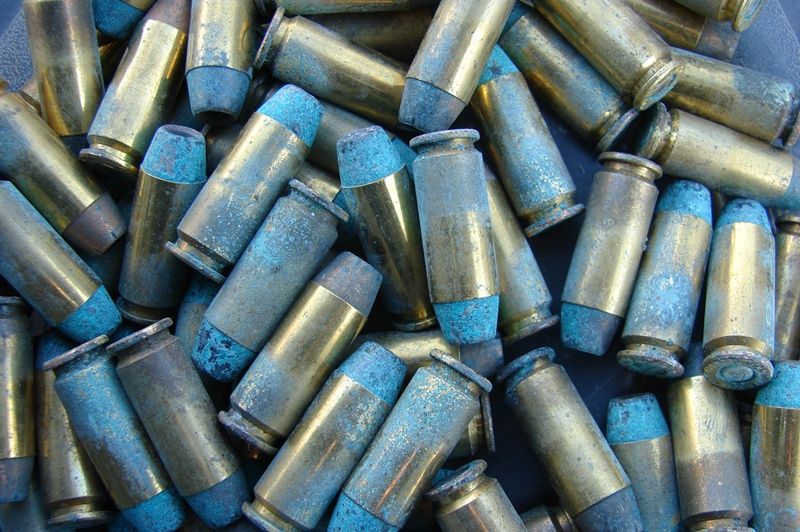 Federal 10mm Auto factory Sierra 180 JHP; brass case. Consistent, with no failures to fire thus far.  200 yards----Colt Delta Elite with Federal/Sierra 180 JHP. Dent on left: second round hit on stainless dairy pot. (Dent on right from Ruger 03 .45 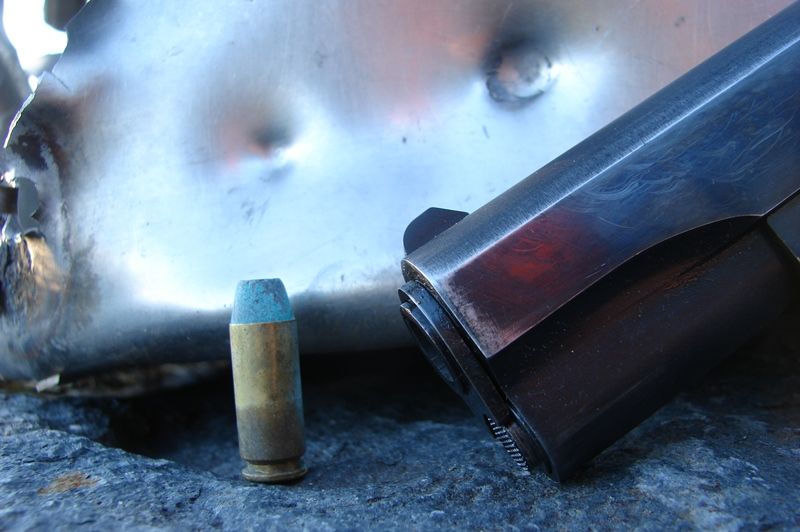 -Lee www.singleactions.com"Building carpal tunnel one round at a time" |
|
|
|
Post by serialsolver on Oct 28, 2013 19:07:43 GMT -5
mr. bradshaw, how is the chamber of the colt after firing the corroded ammo? I ask because I fired some corroded 12 ga in a 870 that scarred the chamber causing some hard extraction.
|
|
|
|
Post by bradshaw on Oct 29, 2013 8:39:40 GMT -5
serialsolver.... thank you for inquiring. Chamber looks fine. With you in mind, I'll take a closer look on next teardown. Contrary to my first report of the Colt being remarkably clean for shooting the corroded ammo, and cycling the failure-to-chamber and failure-to-fire CCI aluminum Blazer, the pistol accumulated quite a bit of crap on the second session. Although, for whatever reason, very little debris in mag well. Pistol well lubed with motor oil. Surprised, that corroded 12 gauge would score a Remington 870 chamber. My experience with corroded 12 gauge involves flash-plated steel bases, with swelling of cases which prevented much of it from chambering. I would expect corrosion in the form of rust on a steel hull to be much harder than oxidation on brass or aluminum. Unlike rust, the aluminum crumbles to powder in your fingers. Nevertheless, besides friction, it must possess abrasive qualities.
While I have yet to shoot the Delta Elite at 100 yards with corroded Hornady and Federal 10mm, the dozen rounds of Federal fired at 200 yards show a serious inclination to accuracy, as in the 1-foot area. I'll try to ignore fall chores long enough to get in more range time.
David Bradshaw
|
|
|
|
Post by oldschool on Oct 29, 2013 12:55:47 GMT -5
Had the aluminum case heads blown out under 35,000-40,000 psi, I believe the magazine would have departed the mag well, and the grips bulged. The Colt has excellent chamber support; otherwise, case failure should have been worse. With chronograph gear put away, I shall rely on 100 yard targets to indicate load consistency. Amazes me how clean the Colt 10mm is after firing such filthy ammunition. (Photos taken of CLEAN pistol). David, did Pachmayer make the rubber grips for the Delta? If so, I imagine they are steel-lined, as are their aftermarket grips for the 1911. I put some on my Gold Cup years ago as insurance to protect my hands, should a round rupture and pressure was diverted into the mag well. |
|
|
|
Post by serialsolver on Oct 29, 2013 19:00:15 GMT -5
mr bradshaw, I fired a rusty slug in a 870 I was trying to sight in that marred the chamber. it left some small scratches in the chamber. I was surprised about the chamber also. at my previous employer a major shipping company would donate ammo to my agency that had been damaged in shipping. I would clean the ammo that was corroded like yours with hog hair. if the ammo would chamber I would shoot it. after the 870 I was a lot more selective in what I shot.
|
|